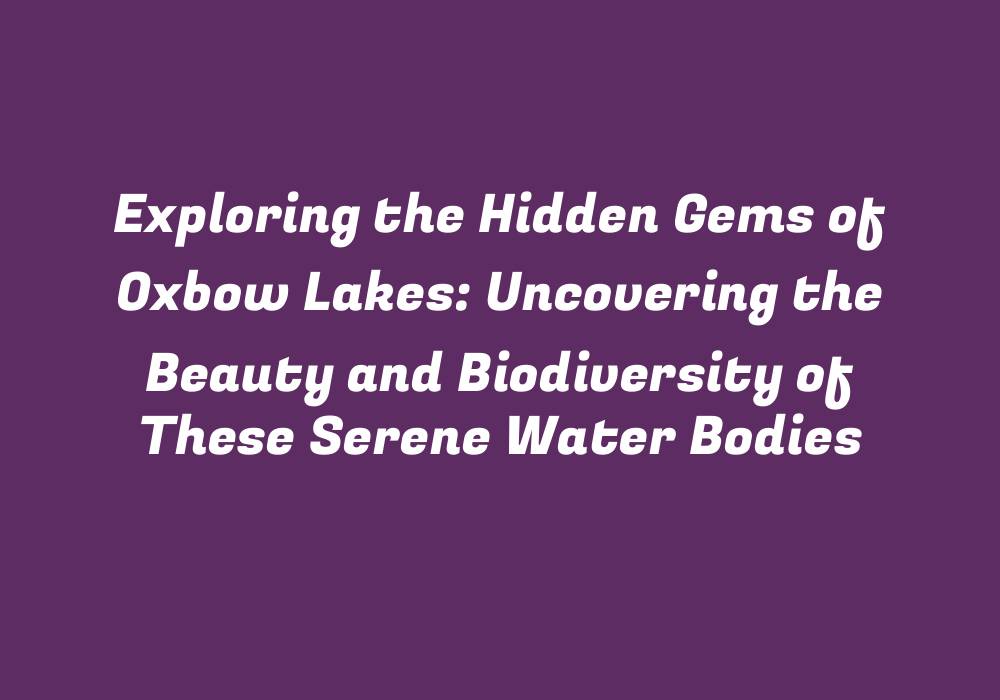Introduction
Oxbow lakes, sometimes known as meanders or ox-bows, are fascinating examples of nature’s beauty and ingenuity. These unique water bodies result from a river’s bend turning into a closed loop due to erosion and deposition, eventually forming an isolated lake or pond. The formation process is captivating but not the only reason why these lakes are attracting attention for their hidden gems and rich biodiversity.
What Makes Oxbow Lakes Special
Oxbow lakes offer a variety of advantages that contribute to their beauty and unique appeal. Some of the reasons include: enhanced habitat diversity, supporting diverse species and ecosystems, increased water quality, and flood management benefits. Furthermore, these lakes play a vital role in maintaining overall ecological health by supporting a range of flora and fauna.
Enhancing Habitat Diversity
Oxbow lakes provide a diverse range of habitats to an array of plant and animal species. The varied habitat types can include wetlands, marshes, shallow water, and deep water ecosystems – all within one location. This diversity encourages various plant species, such as rushes, sedges, reeds, and willows to thrive along the lakes’ shores and in its waters.
Supporting Diverse Species and Ecosystems
The habitat diversity within oxbow lakes attracts a wide range of plant and animal species, further enhancing their ecological value. These include waterfowl like herons, egrets, and ducks; wading birds such as cormorants and ibis; fish like bass, catfish, and sunfish; and numerous invertebrates including mollusks, insects, and crustaceans. Moreover, oxbow lakes offer a safe haven for aquatic species that may have been endangered by the fast-paced river currents.
Increased Water Quality
Owing to their isolated nature, oxbow lakes enjoy higher water quality compared to main river channels. This is primarily because they are less exposed to contaminants and sediments from the surrounding landscape. Additionally, as these water bodies tend to have a slower current, more time is provided for sedimentation and settling of particles that might otherwise pollute downstream waters.
Flood Management Benefits
Oxbow lakes serve as natural floodplains, absorbing excess water during floods and releasing it gradually. This process helps reduce the risk of flooding downriver while recharging groundwater supplies. Furthermore, oxbow lakes are an essential part of a river’s overall ecosystem, functioning as a buffer between the main channel and its surrounding environments.
Conclusion
Oxbow lakes are not just picturesque water bodies but also important natural resources that contribute to overall biodiversity. They offer diverse habitats for numerous plant and animal species, enhance ecosystem services such as flood management, promote water quality improvement, and preserve vital ecological processes. These fascinating landforms serve as a testament to the resilience of nature, making them an invaluable asset for future generations.
Exploring More Hidden Gems
To delve deeper into the hidden gems and biodiversity of oxbow lakes, consider visiting these remarkable locations worldwide. Some notable examples include:
– The Grand Canyon’s Oxbow Bend (USA) – A serene spot along the Colorado River that has attracted artists and photographers alike.
– Lake Lonar in Maharashtra, India – This ancient meteorite impact crater, which later became an oxbow lake, supports a diverse array of flora and fauna including endemic fish species.
– The Amazon River’s Oxbow Lakes (South America) – These lakes provide critical habitat for many rare and endangered species like the giant river otter, while also providing an invaluable resource for the surrounding indigenous communities.
Final Remarks
Oxbow lakes serve as a testament to nature’s intricate design and endless biodiversity. By understanding their unique features and ecological significance, we can better appreciate these hidden gems and protect them for future generations to enjoy.
